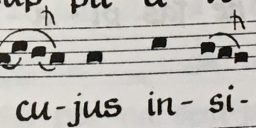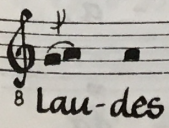Gregorian symbol
-
Does anyone know what this 'h' symbol is? In the second picture it is upsidedown.

 Screen Shot 2019-10-31 at 3.39.11 PM.png1124 x 494 - 305K
Screen Shot 2019-10-31 at 3.39.11 PM.png1124 x 494 - 305K
 Screen Shot 2019-10-31 at 3.39.19 PM.png614 x 464 - 152KThanked by 1JonathanLC
Screen Shot 2019-10-31 at 3.39.19 PM.png614 x 464 - 152KThanked by 1JonathanLC -
I presume it is a liquescent note; in your examples, it comes at positions where such notes would be desirable.
-
I think you are right. I see that word thrown around. What does it mean in this case? Both examples are in treble clef, by the way. Below is another example where the symbol occurs above no note.

 Screen Shot 2019-11-15 at 9.45.11 AM.png870 x 598 - 716K
Screen Shot 2019-11-15 at 9.45.11 AM.png870 x 598 - 716K -
Liquescent notes are fundamentally reminders of good diction/phonation. In the example you posted where the symbol is reversed, notice that the second note is higher than the first, so it is considered ascending rather than descending, as in the other examples.
Go here:
http://www.newadvent.org/cathen/10765b.htm
ctrl+F and search for liq, which will take you to the pertinent section
Then do the same in this article:
https://forum.musicasacra.com/forum/uploads/FileUpload/10/6fb87040ab599517f709f0af311841.pdf
That article goes into augmentative versus diminutive liquescence. In the oldest manuscripts, the same symbol is used for augmentative liquescence on a syllabic (single-note) neume and for diminutive liquescence at the end of a multi-note neume.Thanked by 1CHGiffen -
Thank you very much. Those links are helpful.
It's strange to me that these small details in pronunciation were included in 11th century music. For me, it would be nice to hear a professional sing a phrase with and without this 'liquescent' symbol.
Welcome to the MusicaSacra Forum!
To participate in the discussions on Catholic church music, sign in or register as a forum member, The forum is a project of the Church Music Association of America.
Categories
- All Discussions21,093
- General Music Discussion8,210
- Job Openings195
- Management of Music Programs850
- Choral Matters532
- Church Documents and Rubrics524
- CMAA Notes301
- Events716
- For Newcomers: Read First26
- Sacred Polyphony546
- Hymnody872
- Gregorian Chant: General2,697
- ↳ Graduale Romanum and Liber Usualis368
- ↳ Graduale Simplex60
- ↳ Semiology63
- Vernacular Plainsong696
- Anglican Use and Anglican Chant68
- Organ, Other Instruments and Repertoire435
- New Composition/Works in Progress1,290
- Recordings230
- Music for Hispanic Ministry159
- Music Education: Children211
- Music Education: General222
- News Items245
- Positions Wanted2
- General Discussion: Catholicism739
- Amusements177
- General Discussion1,033
- Opinions117
